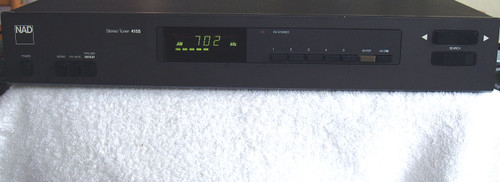HISTORY:
Don't get confused, I see these tuners offered on fleabay as ST-120's and made in Australia - if the seller looked at their own photographs they would see that they have a ST-12 in front of them and it is definitely made in Japan (rear ID label)!
This is a classic, analog tuner design intended for the domestic market. No fancy bells and whistles, just commonsense layout design and well engineered.
During most of the 20th century AWA was Australia's largest and most prominent electronics organisation, undertaking development, manufacture and distribution of radio, telecommunications, television, audio equipment, broadcasting services and considerable work with Australian Defence. Times, they are a changin' (as Mr Dylan once said) and AWA was experiencing considerable pressure from imported products, not at all helped by the Australian government (Whitlam) removing import tariffs, the 'protectionist era' was finished.
From the late 1970s, domestic appliances such as TVs, VCR's, Stereo systems were being made by Mitsubishi Electric, Japan but badged AWA.
This ST-12 tuner is an example of one audio product from that era.
I am not sure if AWA designed the tuner or the whole project was in the hands of the Japanese but it has been well laid out using good (but not great) quality components and mechanics.
Folded sheet steel is used for the casing and the front panel is solid Aluminium. This makes the unit quite heavy at 4.2Kg
When powered up it has a nice 'glow' to the front display and is very easy to 'tune your stations' and they stay on frequency with no drift observed, even in higher temperatures (at one stage during testing on the outside deck, it was 40 degrees ambient and this didn't bother the tuner one little bit)
So let's get down to the description proper ....
AWA - AM/FM Tuner
Model: ST-12
Circa mid 1980's
Australian AC 2 pin plug (NO earth), this was intended for the Australian market (240V AC) and has not been modified
Technology: Analog (completely devoid of digital RF or Audio processing)
Matt Black plastisized coating over the base steel case.
Brushed Aluminium front panel
Glass front display panel
Hybrid lighting used ... the side lighting for the display is based on an incandescent lilliput lamp however the other indicators (Tuning etc) are LED's
Standard frequency ranges:
AM: 530Khz ~ 1600Khz
FM: 88Mhz ~ 108Mhz
There are no selectivity controls, filters etc ... this is a basic tuner which leaves out the 'fancy bits'
Manufacturers specifications are unknown but what is important is the sensitivity and I can only describe this as 'very good' on both AM & FM
I undertook my testing within a highly RF shielded area, a little like a Faraday cage, used the built in AM loop antenna and a very short length of wire (30cm) for FM and had absolutely no problems dragging in good solid signals which easily locked in Stereo when on FM. This tuner is NOT deaf!
Output is via a fixed audio lead, 70cm in length and terminated with colour coded RCA male plugs - pretty standard.
DIMENSIONS:
250mm deep x 84mm height x 433mm wide
This is quite a large tuner but at one stage we did have this sitting on a standard rack unit shelf - looks great! (and sounds great too). This was actually patched to some off-air monitoring equipment when we needed to monitor/record commercial radio broadcasts as required.
WEIGHT:
4.2Kg
COSMETIC CONDITION:
USED
CLEAN (Very)
NO signs of the 'elements' but I was surprised to find this patch of oxidisation (yes, that means rust) but it is surface only with nothing showing on the opposite side of the sheet metal and no other strange marks on the casing. No idea how that mark came to be, but it is there anyway.
NO bent or damaged casing, all is straight and true
NO serious or significant scratching, even on the front panel. The worst would be a couple of light scratches on the front of the tuning knob, that's it.
Rear panel is nice and clean.
ALL labelling is clear and easy to read
Inside is also very clean (I like to take a look around!)
TESTING:
Although we used this as some of our 'standard kit' when monitoring some broadcast station material (Listen to this! they are playing our song ... some of our clients made it to the 'big time' and had their music broadcast on-air, what a buzz for the artist, so we recorded the announcer intro and the music and gave a copy to the artist) All that happened via this tuner.
Alas, since those days way back in the mists of time, it had been sitting in our storeroom for 'many moons' so I have been using this constantly over the last few weeks to check its operation and also test some amplifiers I am working on at the moment.
The up shot is that there is absolutely nothing wrong with this gear ... nice!
Oh for those who like to know a bit more techie information ...
Large amount of empty real-estate inside
Single sided PCB with components mounted horizontally
Wire wrap terminal pins (mainly) which are actually more reliable than soldered connections (greater contact surface area) but wirewrap doesn't lend itself to automated manufacturing processes.
Only two ic's inside, one is an HA12413 (AM/FM IF system on a chip) and the other is a JRC4560D, an audio Op amp.
No digital gizmo's and certainly no PLL circuits, just good old LC tuning.
Surprisingly small multi-gang tuning capacitor
Nicely laid out mechanics for tuning which has no noticeable 'whip lash'
Left side incandescent lamp illuminates through the side of the front panel glass (just above the power ON-OFF switch) giving a nice even glow to the whole front display area
The most surprising thing (to me) is the absence of an AC mains input fuse....nada zero here. AC goes straight to the transformer via the front panel ON-OFF switch. The secondary output from the transformer also has no fusing.
I hope this is enough information for those who are interested in this very retro type of audio equipment and now it is sitting patiently on the shelf (protected within clear plastic) waiting for a new owner to bring it back to life once again (I want to live, I want to live, I can hear it saying)















